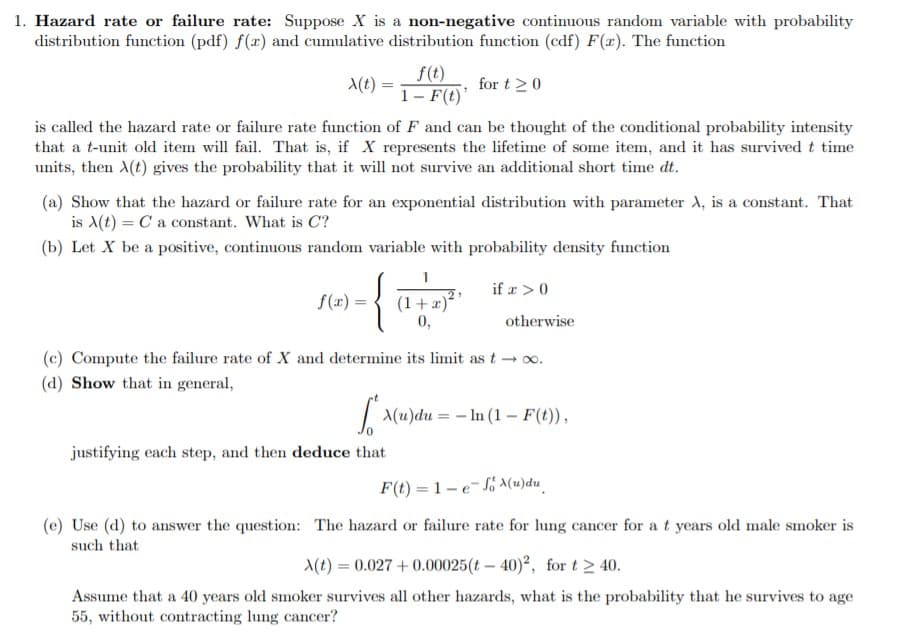1. Hazard rate or failure rate: Suppose X is a non-negative continuous random variable with probability distribution function (pdf) f(a) and cumulative distribution function (edf) F(x). The function f(t) 1 F(t) is called the hazard rate or failure rate function of F and can be thought of the conditional probability intensity that a t-unit old item will fail. That is, if X represents the lifetime of some item, and it has survived t time t) for t 20 units, then A(t) gives the probability that it will not survive an additional short time dt. (a) Show that the hazard or failure rate for an exponential distribution with parameter A, is a constant. That is A(t) Ca constant. What is C (b) Let X be a positive, continuous random variable with probability density function { if > 0 2 (1+) 0, f (x) = otherwise (c) Compute the failure rate of X and determine its limit as t oo. (d) Show that in general, (u)duIn (1 F(t), justifying each step, and then deduce that F(t) 1-eJo a(u)du (e) Use (d) to answer the question: The hazard or failure rate for lung cancer for at years old male smoker is such that t)0.027+0.00025(t 40)2, for t 40 Assume that a 40 years old smoker survives all other hazards, what is the probability that he survives to age 55, without contracting lung cancer?
1. Hazard rate or failure rate: Suppose X is a non-negative continuous random variable with probability distribution function (pdf) f(a) and cumulative distribution function (edf) F(x). The function f(t) 1 F(t) is called the hazard rate or failure rate function of F and can be thought of the conditional probability intensity that a t-unit old item will fail. That is, if X represents the lifetime of some item, and it has survived t time t) for t 20 units, then A(t) gives the probability that it will not survive an additional short time dt. (a) Show that the hazard or failure rate for an exponential distribution with parameter A, is a constant. That is A(t) Ca constant. What is C (b) Let X be a positive, continuous random variable with probability density function { if > 0 2 (1+) 0, f (x) = otherwise (c) Compute the failure rate of X and determine its limit as t oo. (d) Show that in general, (u)duIn (1 F(t), justifying each step, and then deduce that F(t) 1-eJo a(u)du (e) Use (d) to answer the question: The hazard or failure rate for lung cancer for at years old male smoker is such that t)0.027+0.00025(t 40)2, for t 40 Assume that a 40 years old smoker survives all other hazards, what is the probability that he survives to age 55, without contracting lung cancer?
Functions and Change: A Modeling Approach to College Algebra (MindTap Course List)
6th Edition
ISBN:9781337111348
Author:Bruce Crauder, Benny Evans, Alan Noell
Publisher:Bruce Crauder, Benny Evans, Alan Noell
Chapter5: A Survey Of Other Common Functions
Section5.6: Higher-degree Polynomials And Rational Functions
Problem 5E: Population Genetics In the study of population genetics, an important measure of inbreeding is the...
Related questions
Question
Just d,e

Transcribed Image Text:1. Hazard rate or failure rate: Suppose X is a non-negative continuous random variable with probability
distribution function (pdf) f(a) and cumulative distribution function (edf) F(x). The function
f(t)
1 F(t)
is called the hazard rate or failure rate function of F and can be thought of the conditional probability intensity
that a t-unit old item will fail. That is, if X represents the lifetime of some item, and it has survived t time
t)
for t 20
units, then A(t) gives the probability that it will not survive an additional short time dt.
(a) Show that the hazard or failure rate for an exponential distribution with parameter A, is a constant. That
is A(t) Ca constant. What is C
(b) Let X be a positive, continuous random variable with probability density function
{
if > 0
2
(1+)
0,
f (x) =
otherwise
(c) Compute the failure rate of X and determine its limit as t oo.
(d) Show that in general,
(u)duIn (1 F(t),
justifying each step, and then deduce that
F(t) 1-eJo a(u)du
(e) Use (d) to answer the question: The hazard or failure rate for lung cancer for at years old male smoker is
such that
t)0.027+0.00025(t 40)2, for t 40
Assume that a 40 years old smoker survives all other hazards, what is the probability that he survives to age
55, without contracting lung cancer?
Expert Solution
This question has been solved!
Explore an expertly crafted, step-by-step solution for a thorough understanding of key concepts.
This is a popular solution!
Trending now
This is a popular solution!
Step by step
Solved in 3 steps with 3 images

Knowledge Booster
Learn more about
Need a deep-dive on the concept behind this application? Look no further. Learn more about this topic, statistics and related others by exploring similar questions and additional content below.Recommended textbooks for you

Functions and Change: A Modeling Approach to Coll…
Algebra
ISBN:
9781337111348
Author:
Bruce Crauder, Benny Evans, Alan Noell
Publisher:
Cengage Learning

Glencoe Algebra 1, Student Edition, 9780079039897…
Algebra
ISBN:
9780079039897
Author:
Carter
Publisher:
McGraw Hill

Functions and Change: A Modeling Approach to Coll…
Algebra
ISBN:
9781337111348
Author:
Bruce Crauder, Benny Evans, Alan Noell
Publisher:
Cengage Learning

Glencoe Algebra 1, Student Edition, 9780079039897…
Algebra
ISBN:
9780079039897
Author:
Carter
Publisher:
McGraw Hill